


xxxxxJoseph Mallord William Turner was one of England’s greatest and most original landscape artists. He attended the Royal Academy school and then, together with his friend and rival Thomas Girtin, studied at the academy run by the art collector Thomas Monro. At first he painted picturesque landscapes to make a good living, but his abiding love of water and boats also produced an array of brilliant sea pieces, ranging from the serene to the tempestuous. His style was mainly influenced by the works of Cozens, Canaletto, Claude Lorrain and Richard Wilson. He travelled widely to find worthy subjects, and his visits abroad introduced him to the purity of Italy’s natural light, and the beauty of Venice. As we shall see (1838 Va), he then began to experiment with a new method of reproducing the effects of light and this, together with his daring use of colour and free brushwork, were to produce the masterpieces of his later years. His major works in this early period included Tintern Abbey (1795), Calais Pier (1803), Frosty Morning (1813), Crossing the Brook (1815), Snowstorm: Hannibal crossing the Alps (1812) and The Bay of Baiae (1823).
JOSEPH MALLORD WILLIAM TURNER
1775 -
Acknowledgements
Turner: Self-
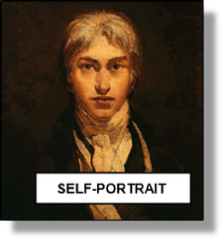 xxxxxJoseph Mallord
William Turner is one of England’s most outstanding and original
landscape artists. Few have matched his varied range of ability, and
none has surpassed him in his bold treatment of the effects of
natural light , seen at its best, perhaps in his pictures of Venice.
Later, as we shall see, his daring use of colour and his free-
xxxxxJoseph Mallord
William Turner is one of England’s most outstanding and original
landscape artists. Few have matched his varied range of ability, and
none has surpassed him in his bold treatment of the effects of
natural light , seen at its best, perhaps in his pictures of Venice.
Later, as we shall see, his daring use of colour and his free-
xxxxxTurner was born in London, the son of a barber. The family lived over his father’s shop in Maiden Lane, Covent Garden. His marked ability at drawing earned him a free place at the Royal Academy school at the age of 14 and, after completing the course in 1793, he worked for three years at No.8 Adelphi Terrace, the home of an art collector named Thomas Monro. It was here, employed as a copyist, that he worked alongside his friend and rival Thomas Girtin, and came to know the paintings and drawings of a variety of artists. He was particularly attracted to the wild, romantic landscapes of the English watercolour artist John Robert Cozens (whom he met) and to drawings of Venice by the Italian painter Antonio Canaletto.
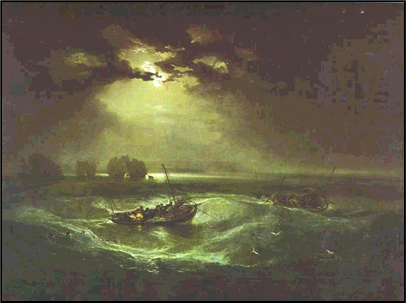 xxxxxIn these early years he worked in watercolour and his
subjects were mostly romantic landscapes or mythological scenes,
dotted with crumbling abbeys and castles to meet the demand for the
picturesque. Within a few years he had more commissions than he
could handle, and had opened his own studio at Hand Court in Maiden
Lane. In the 1790s, however, he began experimenting in oils and
exhibited his first painting in that medium in 1796. A highly
dramatic work entitled Fishermen at Sea (illustrated), it showed the
men as they struggled against gale-
xxxxxIn these early years he worked in watercolour and his
subjects were mostly romantic landscapes or mythological scenes,
dotted with crumbling abbeys and castles to meet the demand for the
picturesque. Within a few years he had more commissions than he
could handle, and had opened his own studio at Hand Court in Maiden
Lane. In the 1790s, however, he began experimenting in oils and
exhibited his first painting in that medium in 1796. A highly
dramatic work entitled Fishermen at Sea (illustrated), it showed the
men as they struggled against gale-
xxxxxIn the spring of
1799 he visited the house of one of his patrons, and saw two
paintings by Claude Lorrain. This awakened an interest in historical
painting, and also encouraged him to experiment with the diffusion
of light -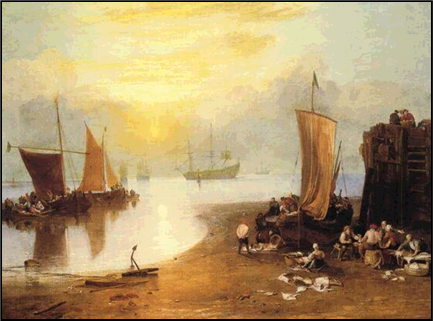 was
to admire so much when he visited Rome. In 1802 he was elected a
full member of the Royal Academy, and it was in that year -
was
to admire so much when he visited Rome. In 1802 he was elected a
full member of the Royal Academy, and it was in that year -
xxxxxIn 1805 he was able to make a drawing of HMS Victory as it entered the Medway, carrying the body of Lord Nelson, and he later went on board and chatted to the crew. Ever since a child Turner had been passionately interested in water and boats, hence his many paintings of the Thames and his fascination with rivers, docks and events at sea. He prided himself on his nautical knowledge, and filled his canvases with vessels and rigging of every shape and size. His dockyard scenes, for example, had all the paraphernalia that clutters a busy wharf. And in all these sea pieces the elements played an atmospheric part, be it fog, early morning mist, the play of sun and moonlight on the water, or the violence of a storm at sea. During his career he made a large number of engravings and he used these to illustrate some of his work, including his Rivers of England and France, and his unfinished Liber Studiorum, a collection of 71 plates demonstrating the different styles of composition he used in his paintings, including historical, pastoral, architectural and, of course, marine. He planned to publish 100 plates, but abandoned the project in 1819.
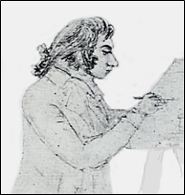 xxxxxWith the war with France over, Turner paid his first
visit to Italy in 1819, and became totally won over by the beauty of
the country, the wealth of its art and, above all, the magic quality
of its natural light. On his return he began to experiment with both
watercolour and oils to find his own means of capturing light by the
use of pure colour. Following a second visit to Italy in 1828,
during which he was captivated by the grandeur and breath-
xxxxxWith the war with France over, Turner paid his first
visit to Italy in 1819, and became totally won over by the beauty of
the country, the wealth of its art and, above all, the magic quality
of its natural light. On his return he began to experiment with both
watercolour and oils to find his own means of capturing light by the
use of pure colour. Following a second visit to Italy in 1828,
during which he was captivated by the grandeur and breath-
xxxxxIn the beginning, Turner’s landscapes were much influenced by Dutch art, but acquaintance with the works of the English painter Robert Cozens and the Welsh artist Richard Wilson gave his paintings a greater degree of imagination and flair, and by the early 1800s he was broadening his approach, based on the works of some of the old masters, notably the 17th century painters Nicolas Poussin, Claude Lorrain, and Aelbert Cuyp. Following his trips to the continent, however, his own, very distinctive style began to evolve, marked by the use of bold, unorthodox colours, an imaginative interpretation, and an original and subtle lighting technique in the creation of atmosphere. Later, as we shall see (1838 Va), he was to develop this style much further, and produce a series of masterpieces which anticipated impressionism and sometimes bordered on the abstract.
Including:
Thomas Girtin and
The Norwich School

xxxxxAmong his outstanding
paintings during this early period were Stoke
House, Bristol (1791), San Giorgio
Maggiore at Dawn (1819) (illustrated
right above), Calais
Pier (1803), Frosty Morning (1813) (illustrated
left above), Snowstorm:
Hannibal Crossing the Alps (1812), Crossing the Brook (1815), Childe
Harold’s Pilgrimage (1819) -
xxxxxIllustrated here are three works from his early years: Childe Harold’s Pilgrimage, Stonehenge, and Quillebeuf at the mouth of the Seine.
G3c-
xxxxxJoseph Turner’s close
friend Thomas Girtin
(1775-
xxxxxThe English painter Thomas Girtin (1775-
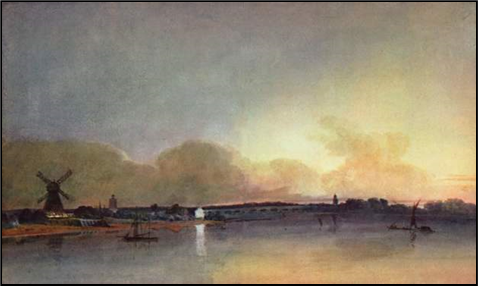 xxxxxIn search of his subject matter, he went on frequent sketching tours across northern England,
Scotland and Wales, but in addition to some magnificent views of the
British countryside, he also produced a series of delightful
etchings of Paris when he visited that city in 1801. In 1802, the
year of his untimely death (when he was only 27) he worked on his Eidometropolis, a large collection of views
from across London, and he just lived long enough to see it put on
exhibition. Six of his sketches for this vast undertaking are held
by the British Museum.
xxxxxIn search of his subject matter, he went on frequent sketching tours across northern England,
Scotland and Wales, but in addition to some magnificent views of the
British countryside, he also produced a series of delightful
etchings of Paris when he visited that city in 1801. In 1802, the
year of his untimely death (when he was only 27) he worked on his Eidometropolis, a large collection of views
from across London, and he just lived long enough to see it put on
exhibition. Six of his sketches for this vast undertaking are held
by the British Museum.
xxxxxParticularly notable among his scenes are his Lichfield Cathedral, View on the Wharfe and The White House at Chelsea (illustrated above), now in the Tate Gallery, London. Such works had a marked influence on the development of landscape painting. We are told that the English artist John Constable showed an interest in his pioneering technique, and that Turner learnt from his friend and recognised his talent. “Had Girtin lived”, he later wrote, “I should have starved”. Shown below are Durham Cathedral, Morpeth Bridge, and Eton College from Datchet Road.,
xxxxxThe Norwich
School of painting was centred around a
flourishing society of local artists specialising in landscapes and
marine subjects. This society, set up in 1803, was mainly due to the
efforts of two men from Norwich, Crome and Cotman. Many of its
members were influenced by the works of the 17th century Dutch
masters, such as Ruisdael and Cuyp. John Crome
(1768-
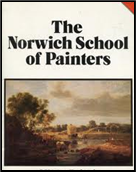 xxxxxEnglish landscape and marine painting, both in
watercolour and oils, was enhanced at this time by the Norwich School, founded in
1803. Made up of amateur as well as professional painters, many of
its members were inspired by Dutch art in this genre, seen
particularly in the serene works of 17th century masters like
Ruisdael, Cuyp, and Hobbema. This Norwich Society of Artists
flourished for thirty years, and produced some outstanding
landscapes of the Norfolk coast and countryside. It was founded by
two local artists John Crome and John Sell Cotman, both of whom
failed to gain recognition in their own time. Today, their paintings
are on show worldwide, and Norwich castle museum contains paintings
by various members of the school.
xxxxxEnglish landscape and marine painting, both in
watercolour and oils, was enhanced at this time by the Norwich School, founded in
1803. Made up of amateur as well as professional painters, many of
its members were inspired by Dutch art in this genre, seen
particularly in the serene works of 17th century masters like
Ruisdael, Cuyp, and Hobbema. This Norwich Society of Artists
flourished for thirty years, and produced some outstanding
landscapes of the Norfolk coast and countryside. It was founded by
two local artists John Crome and John Sell Cotman, both of whom
failed to gain recognition in their own time. Today, their paintings
are on show worldwide, and Norwich castle museum contains paintings
by various members of the school.
xxxxxJohnxCrome (1768-
xxxxxAfter his apprenticeship, he was obliged to earn his living as a drawing teacher in his home town, and this brought him into contact with a wider circle of professional and amateur painters. In 1803, encouraged in particular by the Norwich landscape artist John Cotman, he founded the Norwich Society of Artists, a group which, formed for the mutual improvement of its members, developed into the Norwich School of painting. Within a few years Crome was regarded as the society’s official representative, and was elected its president in 1808.
xxxxxAt first, on the
advice of Cotman -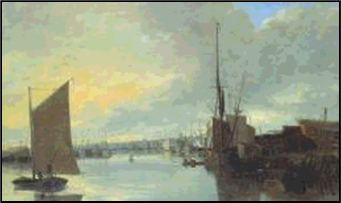 their
composition, the effective use of colour, and the subtle effects
employed to create an atmosphere of both grandeur and tranquillity.
their
composition, the effective use of colour, and the subtle effects
employed to create an atmosphere of both grandeur and tranquillity.
xxxxxSave for short visits
to London, one or two places in England, and a few towns in France
and Belgium, Crome never budged from Norfolk, fully satisfied to
take as his subjects the open skies and peaceful settings around his
birthplace. Nor was he very interested in exhibiting his works
outside of Norwich. In the twelve years from 1806, he only sent 13
works to London. Not surprisingly, he became well known and
respected locally, and in 1801 he was able to buy a large house and
-
xxxxxHis masterpieces included View of Mousehold Heath, a work full of light, air and space, The Slate Quarries, Moonrise on the Marshes of the Yare, Yarmouth Harbour (illustrated above), and The Poringland Oak, a painting worthy of his idol Hobbema. Shown here are Back of the New Mills, A River Scene, and Moonlight, Norwich.
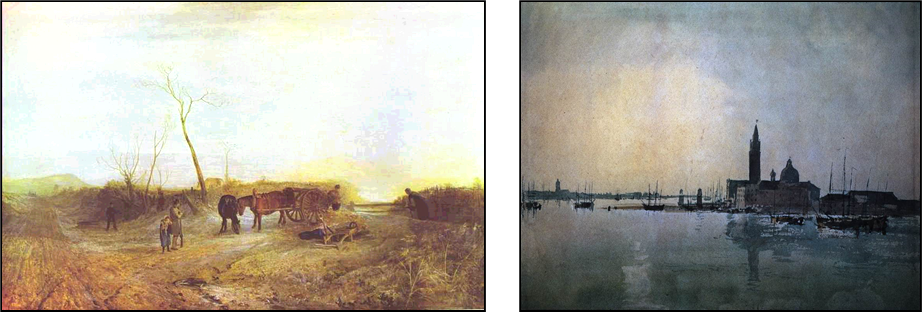

xxxxxIncidentally, the art collector Thomas
Monro (1759-
xxxxx…… Turner’s father was very supportive of his son. He encouraged him to take up painting, and, in the early days, used to display his drawings in his barber’s shop. He sold a few to his customers. Later in his life, after his wife had been committed to a mental hospital, he went to live with Turner, and became his studio assistant and agent. ……
xxxxx……
Turner sold his Sun rising through Vapour
in 1807, soon after painting it, but he bought it back twenty years
later and, together with his Dido Building
Carthage, bequeathed it to the National Gallery. However,
they were given on one condition: that they should always be hung
beside two particular paintings -


xxxxxIncidentally, such was the high esteem in which Crome held Hobbema, that it is reputed that on his death bed his dying words were “Hobbema, Hobbema, how I have loved you”. In his work he certainly captured the kind of idyllic landscapes produced by this Dutch master. ……
xxxxx……
JohnxCromexis
often referred to as ‘Old Crome’ to distinguish him from his son John Berney
Crome (1794-
xxxxxUnlikexCrome,
John Sell Cotman (1782-
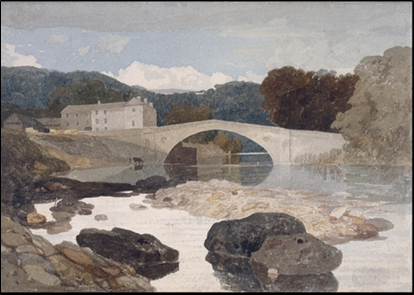 xxxxxFrom 1800 to 1806 he exhibited 30 paintings at the
Royal Academy, and his watercolour landscapes of pastoral scenes of
Yorkshire aroused particular interest because of their originality.
His style, seen at its best in his famous Greta
Bridge of 1805 (illustrated), achieved a fresher, freer
approach by replacing excessive linear design with a bold pattern of
flat washes in cool, harmonious colours. This created a breadth of
vision and a feeling of grandeur not generally associated with the
treatment of this subject. He later turned his hand to oil painting,
but achieved less success in this medium, despite demonstrating a
distinct manner of his own.
xxxxxFrom 1800 to 1806 he exhibited 30 paintings at the
Royal Academy, and his watercolour landscapes of pastoral scenes of
Yorkshire aroused particular interest because of their originality.
His style, seen at its best in his famous Greta
Bridge of 1805 (illustrated), achieved a fresher, freer
approach by replacing excessive linear design with a bold pattern of
flat washes in cool, harmonious colours. This created a breadth of
vision and a feeling of grandeur not generally associated with the
treatment of this subject. He later turned his hand to oil painting,
but achieved less success in this medium, despite demonstrating a
distinct manner of his own.
xxxxxIn 1803, together with
John Crome, he helped to set up the society of artists at Norwich
and returned to live in Norfolk four years later. Here he worked as
a drawing teacher and, on the advice of Crome, concentrated mainly
on landscape painting. In the society’s exhibition of 1808 he
entered over 60 works. In 1811 he went to Yarmouth to teach drawing,
but he continued painting in watercolour and oils. It was here, over
the next ten years, that he produced a series of etchings depicting
the architectural antiquities of England and Normandy. These were
warmly received locally, where he had become well-
xxxxxThe works he left, now highly valued, were sold off cheaply, regarded by many as unfinished because of their simple, broad design and their lack of linear detail. A number are held by the British Museum and the Victoria and Albert Museum in London. Shown here are Snowden, A Ploughed Field, and After the Storm.

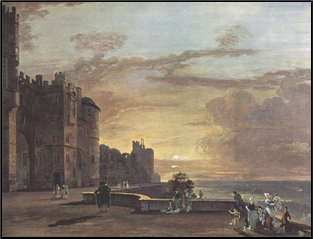 xxxxxThreexother English
watercolour artists deserve to be mentioned here. Paul
Sandby (1725-
xxxxxThreexother English
watercolour artists deserve to be mentioned here. Paul
Sandby (1725-
xxxxxJohnxVarley (1778-

DavidxCox
(1783-
And another of Varley’s pupils was the English
landscape painter Peter De Wint (1784-


